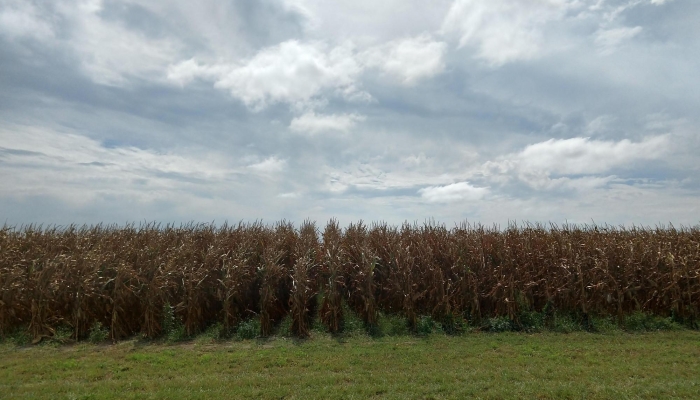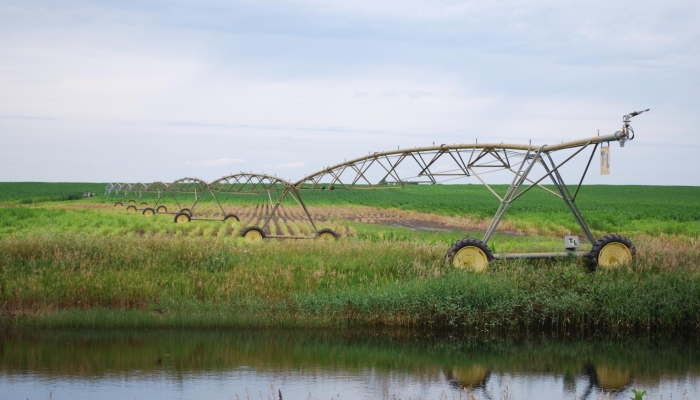Nitrogen Levels in Groundwater Lead to Increased Management
After lively debate, two zones of the Upper Big Blue Natural Resources District are moving from Phase II management to Phase III management as of January 1, 2022. This change is due to elevated median levels of nitrate in the groundwater in these areas. The Upper Big Blue NRD is divided into 12 groundwater quality Management Zones. The median nitrate value for that zone determines the phase of management and therefore, rules and regulations. According to the NRD’s Rule 5, a zone will move into Phase II management at 7 milligrams of nitrogen per liter (mg/L) in median samples and into Phase III at 10 milligrams per liter.
The board of directors of the NRD voted on the resolution to move Zones 6 and 11 to Phase III management at their September 16 meeting with a vote of 10-6 in favor of increased management of these areas. Discussion at the meeting from board members and the public focused on the need to review the data that is used to make these management area decisions, as well as future changes to Rule 5, which governs actions in management areas.
The 2021 median nitrate level for both Zone 6 and Zone 11 is 10 mg/L. The median nitrate value for a zone is the product of water samples collected from a specific network of wells selected based on construction and geology. In Phase I areas, each well in the water quality monitoring network is sampled on a rotation once every three years. In Phase II and III areas, all wells in the zone are sampled annually. Wells sampled include domestic, irrigation, and public municipal uses.
Cities and villages located in Zone 11 include Goehner, Milford, Seward, Tamora, and Utica. Cities and villages in Zone 6 include Henderson, Lushton, and a portion of McCool Junction. Zone 5, which includes the York area, is already under Phase III management due to elevated nitrates. Zone 6 was moved into Phase II management in 2004, while Zone 11 entered Phase II management in 2012. Since that time, the median level of nitrate in these areas has continued to increase.
The last time changes to nitrogen management zones were made in the district was in 2018 when Zone 1 moved from a Phase I to a Phase II designation. Of the district’s 12 Zones, eight show increasing median nitrate levels over the past ten years. (See graphs below)
Nitrate is found naturally in the environment, however excess nitrates that are causing groundwater contamination come primarily from the use of commercial fertilizers. Nitrogen fertilizer is needed to produce maximum corn yields; however the amount and timing of the fertilizer application can reduce the risks of groundwater contamination. Decreasing nitrate contamination in Nebraska's groundwater will require a multifaceted approach of changing policy and practices, as well as improving technologies, over a span of years. This process must be a collaboration between farmers, municipalities, policy makers, and industry, with everyone providing actionable solutions to ensure safe drinking water is available to all Nebraskans.
According to EPA regulations, it is unsafe to consume water that has greater than 10 mg/L, though some studies are exploring possible links to negative health outcomes at much lower levels, including pediatric cancers and birth defects (the rates of which are elevated in Nebraska), as well as reproductive cancers in adults. One of the most direct risks in consuming water high in nitrate is to infants, as it can cause “Blue Baby Syndrome” or methemoglobinemia, where there is not enough oxygen transported in the blood.
Concerned about your water? The NRD offers free analysis for nitrates and bacteria in groundwater for all district residents. Rural domestic wells are not held to public water system regulations; therefore it is the well owners’ responsibility to ensure safe drinking water. These wells should be tested at least once a year for both nitrates and bacteria. If contamination is found, the NRD staff can help you determine next steps to ensure that water is healthy and safe. For more info on our free water testing program, visit the water quality tab of our website and click 'water testing.'
The change from Phase II to Phase III management involves additional steps agricultural producers must take to safeguard the water supply. Fall/winter application of anhydrous ammonia in the Phase III Area must include a nitrification inhibitor, though spring anhydrous application would not require the use of a nitrification inhibitor. Phase II and Phase III producers are also required to use electrical resistance blocks or capacitance probes to schedule irrigation in one field. Scheduling irrigation using soil moisture information can reduce the risk of excess irrigation leaching nutrients from the root zone. Additional soil and water sampling and reporting is also required.
Quick Resource on Management Area Requirements
Increasing nitrates in groundwater have been a concern in the Upper Big Blue NRD for decades. Several communities in the district have found it necessary to construct new wells to comply with state and federal drinking water standards. Some communities have built or are seeking funding to build additional treatment plants to remediate for nitrates and other contaminants. Some rural residents have also replaced domestic wells or installed private water treatment systems to decrease consumption of nitrates.
Since 1996, the NRD has required that producers wait until November 1 to apply fall anhydrous, and to wait until March 1 to apply other formulations of nitrogen fertilizer, as lower soil temperatures stabilize anhydrous and should prevent nitrogen from leaching out of the crop root zone. In parts of the district where groundwater nitrate is the highest, farmers are required by existing regulations to attend training classes, take soil samples, and calculate crop nitrogen needs annually.
The board of directors of the NRD voted on the resolution to move Zones 6 and 11 to Phase III management at their September 16 meeting with a vote of 10-6 in favor of increased management of these areas. Discussion at the meeting from board members and the public focused on the need to review the data that is used to make these management area decisions, as well as future changes to Rule 5, which governs actions in management areas.
The 2021 median nitrate level for both Zone 6 and Zone 11 is 10 mg/L. The median nitrate value for a zone is the product of water samples collected from a specific network of wells selected based on construction and geology. In Phase I areas, each well in the water quality monitoring network is sampled on a rotation once every three years. In Phase II and III areas, all wells in the zone are sampled annually. Wells sampled include domestic, irrigation, and public municipal uses.
Cities and villages located in Zone 11 include Goehner, Milford, Seward, Tamora, and Utica. Cities and villages in Zone 6 include Henderson, Lushton, and a portion of McCool Junction. Zone 5, which includes the York area, is already under Phase III management due to elevated nitrates. Zone 6 was moved into Phase II management in 2004, while Zone 11 entered Phase II management in 2012. Since that time, the median level of nitrate in these areas has continued to increase.
The last time changes to nitrogen management zones were made in the district was in 2018 when Zone 1 moved from a Phase I to a Phase II designation. Of the district’s 12 Zones, eight show increasing median nitrate levels over the past ten years. (See graphs below)
Nitrate is found naturally in the environment, however excess nitrates that are causing groundwater contamination come primarily from the use of commercial fertilizers. Nitrogen fertilizer is needed to produce maximum corn yields; however the amount and timing of the fertilizer application can reduce the risks of groundwater contamination. Decreasing nitrate contamination in Nebraska's groundwater will require a multifaceted approach of changing policy and practices, as well as improving technologies, over a span of years. This process must be a collaboration between farmers, municipalities, policy makers, and industry, with everyone providing actionable solutions to ensure safe drinking water is available to all Nebraskans.
According to EPA regulations, it is unsafe to consume water that has greater than 10 mg/L, though some studies are exploring possible links to negative health outcomes at much lower levels, including pediatric cancers and birth defects (the rates of which are elevated in Nebraska), as well as reproductive cancers in adults. One of the most direct risks in consuming water high in nitrate is to infants, as it can cause “Blue Baby Syndrome” or methemoglobinemia, where there is not enough oxygen transported in the blood.
Concerned about your water? The NRD offers free analysis for nitrates and bacteria in groundwater for all district residents. Rural domestic wells are not held to public water system regulations; therefore it is the well owners’ responsibility to ensure safe drinking water. These wells should be tested at least once a year for both nitrates and bacteria. If contamination is found, the NRD staff can help you determine next steps to ensure that water is healthy and safe. For more info on our free water testing program, visit the water quality tab of our website and click 'water testing.'
The change from Phase II to Phase III management involves additional steps agricultural producers must take to safeguard the water supply. Fall/winter application of anhydrous ammonia in the Phase III Area must include a nitrification inhibitor, though spring anhydrous application would not require the use of a nitrification inhibitor. Phase II and Phase III producers are also required to use electrical resistance blocks or capacitance probes to schedule irrigation in one field. Scheduling irrigation using soil moisture information can reduce the risk of excess irrigation leaching nutrients from the root zone. Additional soil and water sampling and reporting is also required.
Quick Resource on Management Area Requirements
Increasing nitrates in groundwater have been a concern in the Upper Big Blue NRD for decades. Several communities in the district have found it necessary to construct new wells to comply with state and federal drinking water standards. Some communities have built or are seeking funding to build additional treatment plants to remediate for nitrates and other contaminants. Some rural residents have also replaced domestic wells or installed private water treatment systems to decrease consumption of nitrates.
Since 1996, the NRD has required that producers wait until November 1 to apply fall anhydrous, and to wait until March 1 to apply other formulations of nitrogen fertilizer, as lower soil temperatures stabilize anhydrous and should prevent nitrogen from leaching out of the crop root zone. In parts of the district where groundwater nitrate is the highest, farmers are required by existing regulations to attend training classes, take soil samples, and calculate crop nitrogen needs annually.


